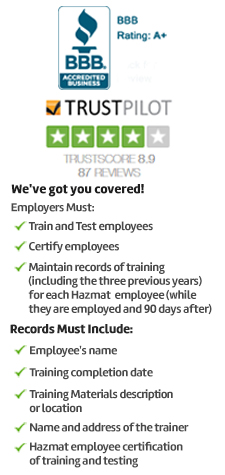
OSHA Industry Chemical Hazards and Toxic

Chemical hazards and toxic substances can pose serious threat to workers’ health and affect productivity. Hence our course has been made as per the guidelines of OSHA which prescribes safety standards for industries where workers may be exposed to hazardous chemicals and other toxic substances.
Though OSHA identifies workplaces involve chemicals and toxic hazards as general industries, it has not specifically mentioned industries such as agriculture, construction or maritime where workers can be exposed to such dangerous health hazards. The online safety course addresses the responsibilities for employers and employees for maintaining workplace safety standards. Participants will learn about the nature of hazards due to chemicals and toxic substances, hazard control measures, federal regulations and safe practices to be followed to protect workers from these hazards.
Governing regulations
OSHA has formulated certain regulations for industries dealing with dangerous chemicals and hazardous substances. These regulations are:
29 CFR 1910 Subpart Z – Toxic and Hazardous Substances; 29 CFR 1910.1000 – Air Contaminants; 29 CFR 1910.1200 – Hazard Communication; 29 CFR 1910.94 – Ventilation, and; 29 CFR 1910 Subpart H – Hazardous Materials.
Course Overview
Students and workers joining this course will get general awareness on chemical hazards, safety standards and regulations, responsibilities of workers and employers towards achieving compliance standards, understanding training requirements for workers, recognizing various health hazards due to chemicals and other toxic substances at workplaces, preventive measures and safe practices. Students also get to understand the key elements of U.S. Occupational Safety and Health Administration’s (OSHA) Hazard Communication Standard and methods to achieve effective control of accidental chemical exposures.
Who Must Take this Course?
Employers are responsible to ensure that workers get maximum protection from workplace hazards. Workers should be effectively communicated about the existence of hazards and trained properly to have clear understanding about the control measures and safe practices to be followed. Hence workers who are exposed to chemicals and other hazardous substances at workplaces should join this course to become qualified safety personnel to handle workplace safety hazards.
Course Format
Our Chemical Hazards and Toxic Substances-General Industry course follows OSHA’s regulation standards and hence the course materials are prepared by a team of safety experts to suit students from various learning standards. Students also get case studies, graphics and audio presentations and practice questions to clear the final exam.
All successful candidates will be given a hard copy of completion certificate and also a printable wallet card.
Continuing education credits?
Each successful candidate will receive 0.2 CEUs (or 2 CMEs) for completing this online safety training program.
Topics Covered
- About This Course
- Course Objectives
- Introduction to Chemical Hazards and Toxic Substances
- Types of Health Hazards
- Toxicology
- Regulations
- State Regulations
- Key Terms
- Occupational Exposure Limits (OELs)
- Routes of Entry
- Best Practices
- Responsibilities-Employers
- Responsibilities-Employees
- Chemical Hygiene Officer
- Training
- Introduction to Chemical Hazards and Toxic Substances
- Types of Health Hazards
- Toxicology
- Regulations
- State Regulations
- Key Terms
- Occupational Exposure Limits (OELs)
- Routes of Entry
- Hazard Awareness
- Recognition of Health Hazards
- Common Health Effects of Chemical Hazards
- Employee Exposure and Medical Records
- Hazard Monitoring
- Hazard Communication Standard (HCS)
- Hazard Classification
- Health Hazard Classes
- Labels
- Safety Data Sheets
- Hazard Communication Program
- Exposure Controls
- Elimination/Substitution
- Engineering Controls
- Administrative and Work Practice Controls
- Personal Protective Equipment
- Respiratory Protection
- Selecting Respiratory Protection
- Respirator Components
- Types of Respirators
- Respiratory Protection Program
- General Industry Chemicals and Toxic Substances
- Gases
- Gas Properties
- Common Hazardous Gases
- Vapors
- Common Hazardous Vapors
- Fumes
- Common Hazardous Fumes
- Dusts and Fibers
- Silica
- Additional Dusts and Fibers
- Mists
- Lead
- Lead Exposure Levels
- Lead-Medical Surveillance
- Hexavalent Chromium
- Cadmium
- Summary
- Additional Resources
- Exam


 NEBOSH CERTIFICATE
NEBOSH CERTIFICATE NEBOSH DIPLOMA
NEBOSH DIPLOMA IOSH
IOSH SAFETY DIPLOMA
SAFETY DIPLOMA CPD UK
CPD UK ROSPA UK
ROSPA UK FOOD SAFETY
FOOD SAFETY 




